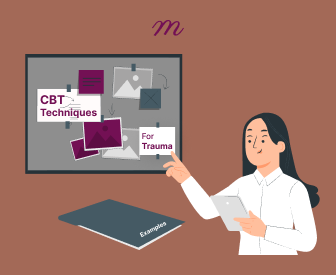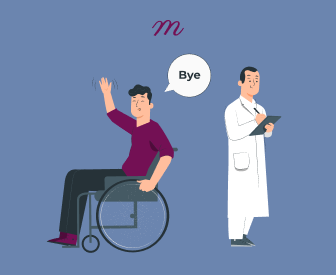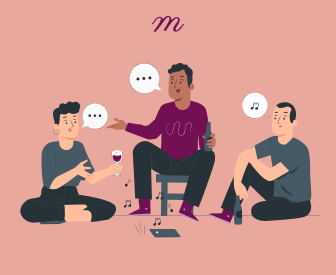Have your progress notes written for you automatically
Trauma-informed Cognitive Behavioral Therapy (TF-CBT) is a type of therapeutic approach used in individual, couples and family psychotherapy. TF-CBT is more collaborative than traditional CBT and incorporates tenets of other trauma therapies with 9 primary trauma-focused techniques. TF-CBT is evidence based and primarily is targeted towards children and their caregivers focused on working through relational and familial trauma, however these techniques can be utilized in other settings as needed (McGuire, Steele, & Singh, 2021).
Techniques of Trauma-informed Cognitive Behavioral Therapy
There are 9 primary techniques of TF-CBT. Many of these are found in other therapy approaches however, the combination of all of them being present in TF-CBT is what makes this approach so unique. The techniques include:
- Psychoeducation: This is where children and caregivers learn about trauma and the impact trauma has on their life. In psychoeducation, individuals learn about their fight, flight, freeze and fawn trauma responses. These trauma responses can vary and change depending on the situations individuals are in. Psychoeducation helps to give context to trauma survivors of what is happening to their body, why and how to be aware of these trauma responses before they respond to a trigger.
Example: Donna a therapist may explain to their client, John, who is coming in for PTSD due to many auditory triggers, why they are triggering him. John has a history of PTSD from time spent in war and when he hears alarms and sirens, he goes into fight vs. flight. Donna is able to explain that his reaction is a typical reaction for PTSD, however it doesn’t mean there is an imminent threat.
- Parenting skills: Therapists help caregivers cope with the children’s behaviors and trauma responses. Parenting skills focuses on helping the adults manage their own emotional responses in a way that doesn’t interfere with their child’s emotional process. Sometimes adults can have a hard time knowing how to respond to their children’s pain or distress so they struggle to show up in an empathic way, and go into a fix-it mode where children aren’t given the space to express themselves. This is usually never due to a malicious reason, rather adults can have challenges around allowing their children to feel because they may struggle to feel their own emotions. These skills help parents show up emotionally for their children.
Example: Donna is a therapist treating Allison, a parent of a child who is having trouble at school with his peers. Donna helps Allison learn better ways to give feedback to her child to put emphasis on the positive behavior they did versus what your opinion is.
- Relaxation: using mindfulness based techniques to regulate emotions and manage distressing emotional experiences. One way of using relaxation is mindfulness meditation or guided meditation. This is where an individual is taken on a mental journey to a place where they can feel more at ease as their environment they are envisioning is more peaceful and healing. Another technique is progressive muscle relaxation. This can be powerful to use and breathing exercises is one way to accomplish this. A therapist can lead you to pace your breaths in such a way where you feel complete control over your emotions. Body scanning is another way to use the relaxation technique. In body scanning, individuals are able to focus on sections of their body at a time and use muscle flexing and relaxing to release tension.
Example: Therapist Donna is working with Amanda and her son Matthew and practicing breathing exercises. She begins with helping Matthew understand what breathing exercises are by making a balloon analogy. She describes breaching in and out like blowing a big balloon. She instructs Amanda to follow along by counting to 1-2-3 and holding for 4 and beginning to count again. Together they are able to learn breathing exercises.
- Affect modulation: Where caregivers and children learn how to regulate their feelings. This is often shown by using graphics such as the feelings wheel, which breaks down primary emotions, secondary emotions and additional specific emotions which can be helpful to identify. Using a feelings wheel can be a great way to learn about emotions and where they come from, and help to identify deeper emotions. The deeper we can go to learn about what we are feeling, the easier it will become to face and challenge moving forward. This technique is a great tool to use in any setting.
Example: Therapist Donna is working with Amanda and Matthew on regulating their emotions. She helps Amanda name her feeling and then identify a number to it for severity. This helps Amanda have more control over her ability to manage her emotion. Donna helps Matthew in a similar way, however uses a visual graphic of a thermometer. The top is really angry and the bottom is very calm. She helps Matthew understand where people may feel and helps John to show her where his feelings are and helps him learn how to regulate those feelings.
- Cognitive processing and restructuring: Learning how to rewrite the negative story caregivers and children tell themselves to come up with healthier patterns of thought. This usually happens when a therapist asks questions which challenge your perspective to help you detach from the current story you are attached to. They may ask you to consider evidence, history, odds and all the possible outcomes. This is a great technique as it really does help to put thoughts into perspective and recognize that as much as we may think something negative may happen, something positive could happen also.
Example: Donna is a therapist working with John who has PTSD. He explains that he feels like he’ll never be able to enjoy big celebrations again and is upset about his triggers. He fears feeling scared all the time in public and its impacting his quality of life. Donna helps John to reframe that thought by challenging it by asking when he has gone out recently and how he has felt. He has been able to recount recent outings where he felt comfortable and able to self soothe more after this conversation.
- Trauma narrative: Recreating the story with new meaning. This is usually done through writing or drawing. Individuals may write out their story and focus on points in their story and explain every single thought and experience they had in great detail. They may also use drawing or captioning their illustrations to share their story and focus on images or scenes that stand out to them most and use those scenes as a way to transform their own perspectives.
Example: Therapist Donna continues to support John who has PTSD struggles with enjoying celebrations due to the large crowds. Donna helps John frame his experiences of trauma around crowds by helping him differentiate the circumstances of crowds during his trauma versus crowds for celebrations. She encourages him to look for evidence that suggests unsafe environments. This helps John change his narrative and put into perspective his experiences in the past versus today.
- In vivo exposure: Exposing children to potential triggers to improve distress tolerance. This is important to consider with children and certain types of trauma. This technique can be really helpful as it slowly introduces individuals to potentially triggering situations or reminders. These triggers would not be dangerous triggers, rather uncomfortable ones in a controlled environment for therapeutic reasons. This can be done by looking at photos of something triggering, rather than being placed in front of it. By doing this, individuals have the ability to challenge what comes up with the guidance of their therapist and can make new meaning from it.
Example: Therapist Donna continues to support John with his fears of crowds by taking their session outside. She encourages him to begin walking outside in the park with him, where there are some people. This exposure will help John become comfortable with outside environments. She has him journal what comes up while he is in the park and again when he is back home.
- Conjoint sessions: Children and caregivers work together to better manage these experiences moving forward. This is a great technique as it can give children the space to share their experiences in a safe environment and also be supported by their therapist in terms of how their caregivers can show up. This is also a great way to support parenting skills by modeling for parents how to show up for children when they are discussing their trauma and experiences. These sessions can be very healing for both children and parents.
Example: Amanda and her son Matthew are seeing therapist Donna for continued support. Donna helps Matthew share his story and offers validation and affirmation that he is in a safe space. Since Amanda is new to a conjoint session, Donna asks Matthew again if its okay that his mother is here and obtains consent. Donna asks Matthew to share the story he told Donna and helps Amanda learn how to listen and offer support and empathy to Matthew versus trying to fix anything. Matthew shares his emotions around a story pertaining to other kids at school and Amanda learns from Donna how to respond so Matthew feels heard. Both feel better and Amanda learns that support can also be just listening and validating Matthews feelings.
- Enhancing safety: Using new skills learned to reduce future risk and trauma experiences. This can be done usually by creating a safety plan or a step by step playbook for how to manage traumatic situations in the future or situations which may be retriggering. The therapist can help the individual through role play to teach them the different ways in which they can respond and what it means to respond differently. There is a lot of psychoeducation also in this technique which is helpful for all. The individual can also create something written to help themselves stay on track. This could be a list of affirmations or reminders to help them remember the different ways in which they are safe (Chipali, 2021).
Example: Donna helps Amanda and Matthew come up with a tool-belt of safety tools that Matthew can use, such as when he is feeling alone, scared or in trouble. Matthew also learns how to stand up for himself with words and helping to learn about his feelings when stressful situations come up. Amanda learns by observing and understanding that Matthew has to learn these techniques and Amanda can help him practice outside of the session, and come up with other tools to enhance his feeling of safety.
Treatment phases of TF-CBT
Treatment phases of TF-CBT include a stabilization phase, a trauma narrative and processing phase and an integration and consolidation phase. This treatment approach usually is aimed at helping children, however TF-CBT can be used for adults as well.
During the stabilization phase, the goal is to help children understand their reactions and experiences by educating them on common types of reactions. When children learn the scope of how their reactions can be typical, it helps to reduce the shame and stigma around their own emotions and gives them the opportunity to recognize their emotional reactions and learn other types of ways to manage emotions. For adults, they learn about their triggers to make sense of what they are experiencing. Adults are better able to understand how these triggers may have formed.
In this phase, there is a lot of emphasis on validating the emotions of children as well as helping them understand their actions are not who they are. This is a big component of this phase. When children can learn to differentiate their experiences and actions from their identity, the feeling of shame starts to dissipate. When we do this, we give children a lot of hope and encouragement of accepting themselves for who they are versus what they’ve been through, as their experiences don’t define who they are as a person. In this phase, children and caregivers both learn about triggers and learn how to identify triggers and how to manage these as they come up.
For caregivers specifically, they learn ways to redirect their children and be clear in their communication to children with a positive tone as to not heighten the stress experienced by the children. Caregivers learn how to manage their own emotional experience as well in order to be present for children. Cognitive processing skills are learned in this stage and children and caregivers learn about how their thoughts impact their emotions and behaviors and how intertwined these things are. Creating the emotional capacity to manage and sit with the challenging emotion is the goal and slowing down to learn about our individual agency can be empowering for all. This helps everyone learn how to better regulate their emotions and caregivers can model good coping skills to help children learn. Relaxation techniques are also encouraged during this time.
During the trauma narrative and processing phase, the goal is for children to share their story of their traumatic experiences, honing in on the emotional and physical experiences they had. Learning about how we experience traumatic events is central to this phase and helps children learn about how their trauma impacts more than their emotions and the impact. When children can understand why they may feel or react in certain ways, they learn how to sit with the emotions that come up. Doing this in the safety of a therapist is why this technique is so effective as the therapist can direct the children to ensure their feeling safety is untouched. Children then learn how to reframe their traumatic experiences so they feel more in control of their feelings and their relationship to the traumatic event. For adults, this phase helps them manage their flashbacks from PTSD. Families and spouses can also be involved in TF-CBT for adults, similar to the treatment approach for children (Mavranezouli, et al., 2020).
During the integration and consolidation phase, children learn how to tolerate their distressing experiences. Sometimes, children may need to try exposure therapy to learn how distressing something may feel however children and caregivers usually work together to make an order of experiences that are least fear inducing to most fear inducing. By doing this, the therapist can work with the children and caregivers to adapt TF-CBT techniques into every day life to cope and manage their emotional responses to what they are feeling (Peters, et al., 2021). Adults on the other hand are able to have a better understanding of what is happening internally and better able to reconcile their triggers.
Examples of TF-CBT
TF-CBT can be utilized in multiple scenarios. In a scenario involving a young female child who witnesses her parents fighting, the child may develop behavioral issues in managing their negative emotions. She may have flashbacks, trouble making friends at school, feeling irritable and generally needing help staying focused on tasks.
TF-CBT can help her work through the experience witnessing her parents fighting by acknowledging the stress and pain she experienced witnessing the fighting. Once she learns and accepts the ways in which this has impacted her, she and her caregivers can learn about how to better manage difficult situations moving forward to prevent further harm to the child and utilize tools to express her emotions in a way that doesn’t produce more harm.
Her caregivers can also utilize these techniques to model for their child how to navigate challenging situations and remove the stigma from the child. She may feel less shame around her feelings and that will ultimately improve her ability to regulate her own emotions moving forward and improve her relationships as she is better able to understand her own experiences.
Other examples of where TF-CBT can be used include:
- Childhood physical and sexual abuse
- Childhood neglect
- Domestic violence
- Substance issues in a parent
- Medical trauma
- Natural disasters
- Immigrant trauma
- Generational trauma
- Racial trauma
- Complicated grief
- Gun violence/school shooting trauma
TF-CBT is a powerful tool used by many therapists to help children and caregivers whose children have experienced trauma. The impact of the TF-CBT is profound and can positively change the course of the child and caregivers lives in how they relate to the trauma. Healing from trauma may be challenging but it is not impossible, and working with a professional is a great way to begin your healing journey.
References
Chipalo, E. (2021). Is trauma focused-cognitive behavioral therapy (TF-CBT) effective in reducing trauma symptoms among traumatized refugee children? A systematic review. Journal of child & adolescent trauma, 14(4), 545-558.
Mavranezouli, I., Megnin-Viggars, O., Daly, C., Dias, S., Welton, N. J., Stockton, S., … & Pilling, S. (2020). Psychological treatments for post-traumatic stress disorder in adults: A network meta-analysis. Psychological medicine, 50(4), 542-555.
McGuire, A., Steele, R. G., & Singh, M. N. (2021). Systematic review on the application of trauma-focused cognitive behavioral therapy (TF-CBT) for preschool-aged children. Clinical Child and Family Psychology Review, 24(1), 20-37.
Peters, W., Rice, S., Cohen, J., Murray, L., Schley, C., Alvarez-Jimenez, M., & Bendall, S. (2021). Trauma-focused cognitive–behavioral therapy (TF-CBT) for interpersonal trauma in transitional-aged youth. Psychological Trauma: Theory, Research, Practice, and Policy, 13(3), 313.










